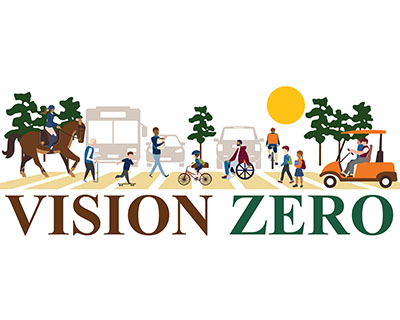A plan to eliminate deaths and serious injuries on Wellington roads by 2030 might sound ambitious enough, but it comes with complications not every place faces — like a thriving equestrian industry bounding beside or across some of its thoroughfares.
Updates on the Vision Zero project presented to Wellington’s Equestrian Preserve Committee on Wednesday, April 3 emphasized not just documented crashes in the past but also situations where people see future problems waiting to happen.
Take a spot where many horses cross Pierson Road to get to and from show events, said Gary Schatz, urban program and project leader for TJKM Transportation Consultants. His group is working with Wellington to present traffic-safety options to the Wellington Village Council in May and June.
“You’ve got riders who are mounted, who are dismounted, who are on motorcycles or electric scooters or a golf cart,” Schatz said. “They’re a whole mix out there.”
No car versus horse crashes were recorded in official data for Wellington from 2013 through 2022, he said. But plenty of other collisions involving vehicles, cyclists and pedestrians claimed the lives of 36 people and left 295 seriously injured on village roads.
Dialing that down to zero may seem difficult or virtually impossible, officials acknowledge, but they argue it is a more defensible goal than shrugging and allowing some “acceptable” number of deaths or injuries.
Official crash numbers don’t always capture everything that happens, Schatz said. They do not include incidents that for one reason or another were never documented in, say, a formal sheriff’s office report, or near misses, or times when people avoided harm but sensed troubling risk.
“That’s what we need to hear about,” Schatz said.
Traffic safety worries of all kinds, and possible suggestions to fix them, can be conveyed through the project’s web site at www.wellingtonvisionzero.com, he said.
The village’s final action plan is likely to include a combination of education and awareness efforts paired with specific proposed changes at certain roads and intersections, closely coordinated with applications for federal or state grants.
Potential moves can include roundabouts instead of traffic signals, adjusted speed limits, narrowed lanes, new or enhanced signs or flashing lights, widened trails or added fences, or other barriers to keep horses and other multi-modal traffic away from cars.
Options for horse and pedestrian crossings can include a push-button box that leads to flashing yellow lights, or a strobe light similar to what some emergency vehicles use, or even a full-stop red light. Each comes with trade-offs, such as the effect on vehicular traffic flow.
There’s also the matter of balancing costs against hoped-for safety benefits. The full-stop red lights, sometimes called pedestrian hybrid beacons, could cost about $200,000 each, Village Engineer Jonathan Reinsvold said.
Traffic counts are underway to help decide whether such costs could be justified, either by conventional industry benchmarks or by applying engineering judgment that it is needed in particular sites, officials said.
Committee members discussed whether the full-stop system might be worth it, at least in a limited number of places, such as the Pierson crossing.
“We can still say, hey, we think there’s a need for it,” Committee Vice Chair Haakon Gangnes said.
Certainly Wellington’s distinctive blend of suburban and pastoral features, encompassing everything from horses to golf carts to high-density traffic on arteries like State Road 7, throws some wrinkles into planning for safety.
Auto-equestrian crashes that have happened in other places reveal not only high risk of injury or death to riders and mounts, but the dynamics of the collision often mean a horse’s high center of gravity is going to send it through a car’s windshield, Schatz said. That very much endangers drivers and passengers, too.
Trying to head off such problems is something the village is rightly pursuing, Committee Chair Glen Fleischer said.
“The Vision Zero concept, both the equestrian component and the overall component, is something that’s very exciting for the village,” he said.
Panel members asked Schatz what he thinks the biggest hurdle will be.
“The biggest challenge to me is getting people to buy into the concept that zero is achievable,” Schatz said.








